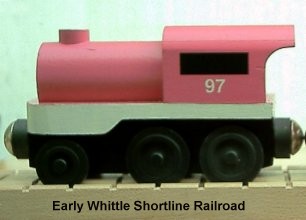
| Main
Train Page |
Buying |
Suppliers |
Historical
Trains 1 |
Historical Page 2 |
Thomas! |
Links Page |
Home Page |
Any prices
mentioned are US$ and are estimates only to be used as a guide.
Please
note that I do
not sell anything at this site, this is just for your
information!

I never got much into trains when I was a child, but when I began to have children of my own, I found I could re-live my youth through them! One of the neatest toys we have purchased over the years have been wooden-rail train sets. There are quite a few different types of sets out there, so I just wanted to share what information I've gathered. Any information on products I missed would be greatly appreciated!
Our Start In Wooden Trains:
Let me begin by explaining how my family started in wooden trains. We had visited some friends of ours, and their son had a BRIO train set. Our oldest son really seemed to take to it, so I knew it was something I'd like to get for him. When I checked the prices, though, I was amazed how expensive they seemed! For a while I considered the BRIO starter set for $40 (at the time), but I kept looking. In the Sportsman's Guide catalog, I noticed some import train sets that offered a lot more track for about the same money. I ended up eventually getting two of these "Dixieland" sets (though different models) so that my sons had lots of track.
For several years we collected wooden trains and sets from
quite a
few different manufacturers. Most of the trains were Learning Curve
Thomas The Tank Engine Trains
and BRIO brand trains, with several of the Lionel/Learning Curve
"realistic" trains added when they first came out.
As I mentioned above, we had started with a couple of import sets from
China. Along the way, we found a decent Playskool Wilderness set on
sale at half price at
Toys 'R Us. We picked up a Tootsietoy Sesame Street train set (on
closeout), and even got a couple of BRIO full train sets. I did
purchase a couple
of Learning Curve track pieces (a crossing and some switch curves), and
I believe one Learning Curve set. One
year, I purchased a Lionel plastic track set (the Mighty Mogul set)
that was availalbe at
40% off. The plastic track was clever in that it could interface with
the wooden track using separately
purchased adapters, and my (at the time) 4 year old son greatly enjoyed
it (I still prefer the wooden track, though). My children are much
older now and most of the track is in storage, but my middle son still
likes to take it out on occassion. Also, this is the type of toy that
will always be useful to hand down to future generations.
Development of Wooden Train Sets:
I think good history of wooden rail sets would make for a good
coffee table book, but here I'll just provide some brief notes based on
information gathered from various sites on the Internet. The pages on "historical wooden trains"
(see tabs above) provide much more detail
Wooden train sets have been available for many, many years, with miniature wooden train and track sets available since at least the 1940's in the United States.
The BRIO company was started in 1884 by the "BRothers
Ivarsson of Osby",
Sweden, and
specialized in wooden toys. They began
making miniature
wooden railroads in 1957. Innovations such as magnetic
couplings
helped establish BRIO trains. US distribution was started by Peter
Reynolds in 1977, and during the 1980s and 1990s, BRIO was the
miniature wooden railway
company against which all others were measured.Today, BRIO in the
United States seems to have lost much of its influence.
T.C. Timber Company was started by Marshal H. Larrabee II in
1936 as
"Skaneateles Handicrafters", and started out as just a hobby. The
company was founded on toy wooden trains. So, even though BRIO may be
an
older company, it appears that T.C. Timber may have been the first to
mass-produce miniature wooden trains! The business was sold to a
German-based toymaker in 1980 and became T.C. Timber/Habermaass
Corporation. More recently, Habermaas has reorganized under the Haba
name, and currently (Oct 2009), Haba seems to have ceased production of
wooden trains.
The Track
Wooden Railways are unique because of the expanded playability. The wooden track pieces can be fashioned into an almost infinite number of configurations, and are usable by even young children of 3 years old.
The train pieces fit together via a locking male/female coupling system as picutred below:
 Image
©
Image
©John Mechalas
On the excellent BRIO® Ray Tracing web site (where this image was borrowed from: http://www.aracnet.com/~seagull/BRIO/BRIO), John Mechalas states the following discovery, "If you look closely at the track joints, as shown in the photo on the right[sic], you see that BRIO track is intentionally designed with a little bit of "play", meaning that you can wiggle the pieces around in the joints to make the track fit together at slight angles and even pull it slightly apart. This is necessary because the curved tracks create 45º angles, and basic geometry tells you that a 45º angle leads to distances that are multiples of the square root of two. It would therefore be extremely difficult to manufacture properly sized tracks that fit together perfectly in even a moderately complex layout. Through the use of this "wiggle room", tracks can instead be pulled around enough to make a decent fit that would otherwise be impossible."
For more information on track and layout design, Dave Barber's site discusses issues of the use of 45-degree angles for train curves and recommends the use of 60-degree curves instead. See: http://home.comcast.net/~tamivox/dave/train/index.html
Another advantage of this wiggle room is that the track is much easier to play with. Some of the plastic sets, although nice, are much more prone to breakage and are harder for little hands to handle because the connections require more force and precision to make. When my middle son was 4 and was playing with his Lionel Great Adventures set, I had to put the track together because his tiny hands just couldn't do it.
Connecting your track together:
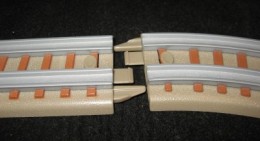 |
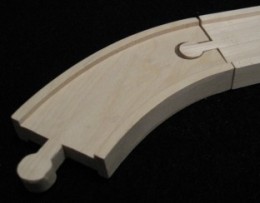 |
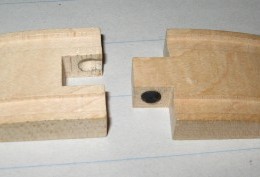 |
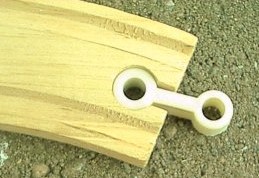 |
A
variety of track connectors are shown here. (1) Top left is plastic
track
from the Lionel Great American Adventure series. (2) Top middle is the
"standard" male/female connectors used today. (3) Top right is an older
Skaneateles Handicrafters pressure fit using a rubber grommet, which is
no longer used. (4) Middle
left is a plastic double-male connector used by a 1990's Dixieland set.
(5) Middle right is a hand-made double-male connector in wood (found on
e-Bay; see the suppliers page).
(6) Bottom left is a ball connector used on some modern track (this one
from BRIO). (7) Bottom middle is the Jack-Built Snap Train connector.
(8) Bottom right is the older Skeneateles Handicrafters pin connector
approach (I don't have any of the pins) |
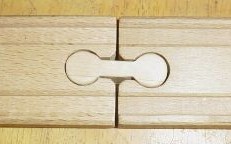 |
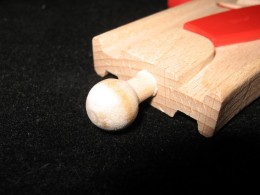 |
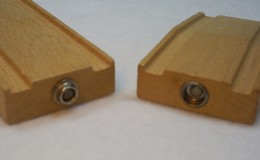 |
 |
A Word About Train and Track Quality:
The trains in our original Dixieland sets were nothing to
speak of,
and in fact were pretty cheap and fell apart easily. I have found this
to be true of the trains with several of the cheap import sets. Often,
the designs are un-inspiring, and the trains simply don't hold up. The
paint chips easily, the wheels fall off, and so forth. However, the
sets
did come with some passable wooden animals and buildings, and the track
in most of the sets is decent and quite workable. The savings in track
allowed us to compile enough track to make a decent setup and provided
enough money left over to purchase some nice Thomas trains.
Since we first started collecting wooden railroads, the range of available accessories has really increased. For example, early BRIO products had few colors and were very "plain" looking. Now you can purchase fully detailed firehouses, working logging stations, and even commercial buildings such as a Texaco gas station. However, one reader (Donna K.) pointed out an area I hadn't really thought of, that of actual play testing. She states,
"For example, Imaginarium railway makes some buildings that are nearly similar to Thomas/Brio quality-wise in materials and construction, but their engineering/toy testing is not nearly as good. I read one review [from Amazon.com, review no longer posted] of a fire house of theirs that had small plastic garage doors that swung open then the fire vehicles backed into the garage on tracks. But there was no other access to the inside of the building for little hands, and the vehicles often fall off the tracks inside the building and the little hands can't get them out. In a Thomas product, there would be engineered into the building a removable roof with a large access for the little hands."
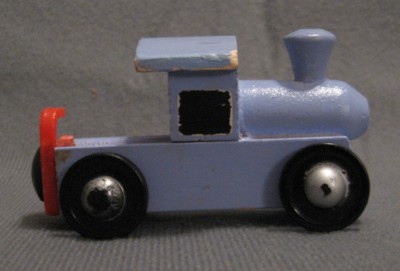 |
At left is an example of a
poor quality train that came with one of my early purchases. The wheels
feel cheap and are flimsy. The paint chipped quickly. If you look
closely, you can see the plastic bracket on the back is broken. There
is no magnet on the front of the engine so the train cannot be pulled
by other
cars. In contrast, the main malfunctions we had with our name-brand trains (like BRIO) are only chipped paint. Also, most of the chipped paint wasn't from play; but rather because we stored our trains all thrown into one box, so they tend to bump against each other quite a bit. |
As far as I know, there is no real "standard" for the development of wooden railroad track and cars. I have seen reference to the term "Vario-System" that supposedly defines the standard for wooden railroads as used by BRIO and others, but I do not know of a formal publication that ever contained this standard.
When reading the advertising for wooden railroad sets, many
will use
the words "Thomas compatible" or "BRIO compatible". At the very
least, compatible
should mean two things: First that you can connect one train set to
another.
For example, even the plastic Lionel track shown in the connector chart
above has an adapter available
that allows you to connect the plastic track to a piece of wooden track
at the same playing level. Second, that MOST of the trains will be wide
enough so that their wheels sit in the groove of the train track.
Compatible should not be taken to mean that all the parts are fully interchangeable, or that every car will work on every track, bridge, or tunnel. In most cases, however, you should find that most of the wooden train tracks will fit okay with the other manufacturers' products.
You may find differences in several areas. The length of the "straights" may not be the same. Some may offer 6" straights, while others are 5.5", for example. The angle of the curves may not quite match. The male/female joints may vary slightly, meaning that a male/female connection might not offer the "play" between the joints as referenced by Mr. Mechalas above. I have had some connectors that fit so tightly the pieces are difficult to separate later, risking breakage if a child gets a little too enthusiatic in taking the pieces apart!
As another example, the Dixieland import track I had originally purchased featured a different track width than my Thomas and BRIO tracks. The inner "hump" of these import tracks is a bit wider than the Thomas track, and the overall width is a little more narrow. This causes some trains to not sit so well in the track, and can lead to derailing, especially if using a battery powered locomotive.
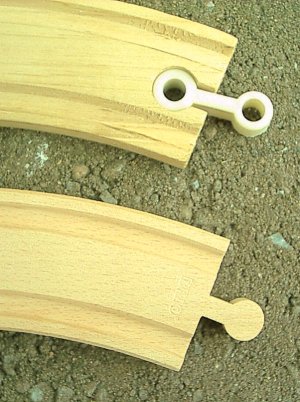 |
The top track in the figure is a piece from the
"Dixieland" first set I purchased. You can note the lower quality of
the track in the roughness of the grooves.Also, the width of the center
hump is a little wider, making some trains not fit as well. The lower track is a selection of BRIO track, and is smooth and well finished. If you look closely, you can just see the faint "BRIO" logo etched in the end. One of the neat features of the Dixieland track is the plastic connectors they used. While not great for small children who might swallow them, all of the Dixlieland track was female at both ends. These little plastic connectors have come in quite handy when you are near the end of your layout and find you have two female connectors facing each other. I have since noticed that a few other manufacturers have used similar connectors. Micki Trains (Sweden), for one, and I saw a photo on e-Bay of an older Playskool set that used them. See the wooden railway suppliers page for some more information. |
In some cases, while the overall "fit" may be fine, you will find that the overall finish of some track manufacturers is just not as nice as the BRIO/Thomas lines. We have broken a few of the connectors of our tracks, and this has usually been the "import" track and not the name brands. In my experience, I have found the Thomas/BRIO lines to be very consistent in both fit and finish. Even the Learning Curve Thomas track and BRIO tracks are not exactly the same size, but for the most part they fit together nicely.
More Examples : The Dazy USA site notes that its SURETRAK will not work properly with TC Timber track, thus we know there are at least some dimensional differences between TC Timber Track and BRIO/Learning Curve. The Whittle Shortline Railroad site notes that some of their longer engines will not operate properly on the short/narrow curves of BRIO/Learning Curve sets. In addition, some sets have low bridges that not all trains will fit under (in particular, letter trains such as those from Maple Landmark are much too high to fit under most any bridge!) I have also purchased some track in which the male/female joints don't even fit well together, and I have to swap pieces until I get a pair that do. If you are building elevated track, you should also realize that the height of risers from various manufacturers may vary a bit, and interconnecting raised track may result in some unexpected pitches and slopes!
Track from the Puzzle World line (no longer available) are
compatible only in
that most trains should fit in the grooves, and a connector is
available that allows you to connect a BRIO or Thomas set to the flat
puzzle pieces.(Puzzle World trains utilized track in the form of square
blocks that you put together like a puzzle, joining the blocks so that
the track portion lined up).
One other area that should be discussed is that of magnets.
The
current wooden train sets use magnets to allow the train cars to attach
to each other. This is great, as the old pin-coupler designs were
either too loose or made connections to difficult for little hands. I
have come across a few trains, however, that have the opposite
North/South pole orientation. For most connections this won't be a
problem, as most train cars can connect either way. There are a few
specialty cars, however, that should be connected "one way". I can't
say I've run into this problem on anything that represents a large
scale, however.
Also, it should be noted that some children who need certain types
of medical equipment cannot play with toys that have magnets, as the
magnet may interfere with the medical device. While some older sets
used to use Hook & Eye connectors, I don't know of any modern
manufacturer who does.
The bottom line in compatibility is thaty you will find that most of your pieces among the various wooden train companies are interchangeable. Just be careful that you don't spend a lot of money expecting complete interoperability!
Track Styles: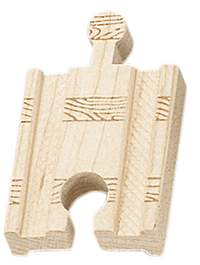 |
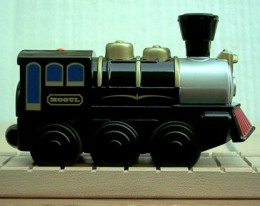 |
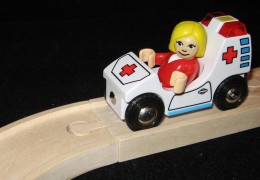 |
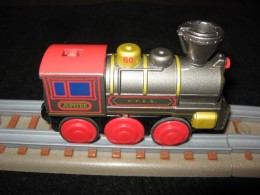 |
Pictured here are a variety of track styles. (1) Top left is current Learning Curve track with "burnt in" graphics. (2) Top middle is the older style Learning Curve "clickety clack" track style with actual grooves cut in. (3) Top right is ERTL Hometown roadway designed for cars. (4) Middle left is Lionel Great American Adventure plastic track. (5) Middle right is Heros flexible track. | 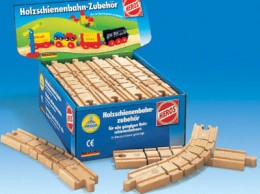 |
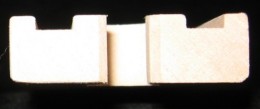 |
Track can sometimes be turned over. For most companies, straight track pieces are one sided only, while curves are routed on both sides so that the curve can go one way or the other. Some companies make track that is cut for trains on one side, and is smooth "road" track on the other. | 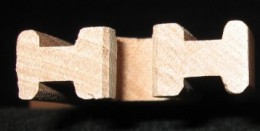 |
Train Connectors:
Not only do you have to connect the train track together, you also have to deal with connecting the trains themselves. Old trains used the standard hook and hook-eye connectors. One advantage of this is that the trains will not normally come apart while playing on a track, so your child can have very long trains without fear of a disconnect. There were several disadvantages, however. 1) The connectors tended to get bent during play. I have seen this on many samples of older trains. 2) The hook connecter has a sharp end to it, which could lead to minor scratches during play. 3) You cannot disconnect two trains without lifting the train from the track, making realistic play more difficult (things like backing a car into a shed for repair and disconnecting it, for example).
Magnets
came to the rescue in the 1970's or 1980's or thereabouts. Magnetic
connectors overcome all three disadvantages above. Their main
disadvantage has been their tendency to disconnect inadvertantly during
play, especially when pulling long trains. Manufacturers have come up
with stronger magnets and implemented flexible connections to help
alleviate this problem. Also, as noted above, some children cannot play
with toys that have magnets in them because of specialized medical
equipment they need to wear or have implanted.
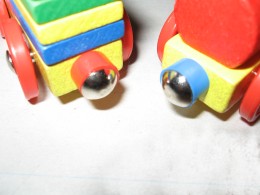 |
|
|
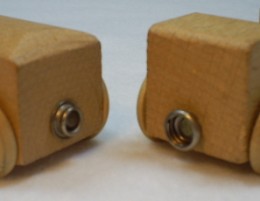 |
Across the top are a selection of magnetic couplers commonly found today. (1) Top left are Heros couplers that are color coded for positive/negative magnet connection. (2) Top middle and (3) right are four samples of how the magnets are connected to the wooden trains. (4) Middle left is a shot of the Jack-Built Snap train connector. (5) Middle right is the unique magnets used by the Learning Curve Great American Adventure trains. (6) At bottom left is the hook and hook-eye connectors that were very common up into the 1970's or so. (7) Bottom middle is a comparison between a 1970's BRIO set on the bottom, and the more modern connectors (from the 1980's) at the top of the photo. (8) Finally, bottom right shows a flexible connector used on a BRIO engine to allow for better connection during turns. | 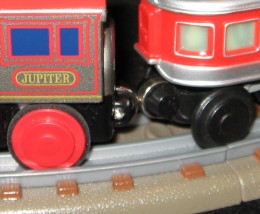 |
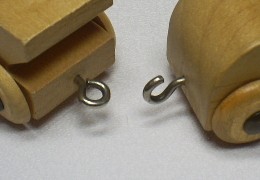 |
 |
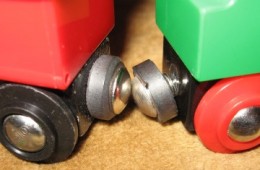 |
Shopping for Wooden Trains:
Let The Buyer Beware! Internet shopping, though quite convenient, can still be a risk. I have seen several wooden train web sites come and go, so use caution where you shop.
One clue is to try and note the last time a web-site has been updated. You can often tell by looking at the date of the last newsletter or sale, for example. Some sites even have "last update" dates posted somewhere on the page.
If a site seems like it hasn't been updated in some time, I would certainly try calling or e-mailing the company before making an on-line order to be sure the prices are still the same and that the items are in stock. There are some companies that do extensive "brick and mortar" sales, and just use the Internet to reach out a little farther, so an old site isn't necessarily the sign of a poor company, but I personally would use extra caution.
Imports & e-Bay:
If you search on the Internet for wooden train sets, or browse the e-Bay listings under TOYS:TRAINS or TOYS:WOODEN, you will discover that there are a lot of inexpensive import train sets available. Many of these sets appear to be those produced by Maxim Enterprise, even though the specific manufacturer is rarely stated. While the Maxim sets are good, there are other import sets out there of questionable quality. The trains in many of the no-name sets are often pretty boring and not well made. Especially if your child is young, you won't want train pieces breaking off to be swallowed! However, it may be worth it to you to purchase a no-name set if you want to add track at minimal cost. Be careful, however, as compatibility also varies quite a bit. I have a few pieces that don't fit even at the male/female joints.
Also, be careful of sellers who say they are selling "BRIO" track. Some people don't seem to know the difference between the different manufacturers, and I have seen many non-BRIO sets being sold as BRIO. I don't think most of these people are being intentionally mis-leading, I just don't think they realize what they have is not BRIO.
Finally, if you are going to purchase a no-name brand wooden train set, especially over the Internet, beware what you are getting. Some "50 piece" sets offer lots of wooden animals and trees, and not as much track as you might expect. You might get 20 animals and trees, 5 train cars, and only 25 track pieces, for example.
My Recommendations:My children liked the Learning Curve Thomas the Tank Engine trains the best, with some of the interesting BRIO and Lionel Great Adventure trains (no longer available) a close second. I can also vouch for the quality of the Whittle Shortline Railroad trains, especially if you want "real" train models.
As for track, I would recommend purchasing some of the large train sets from Eichhorn or Maxim Enterprise. These are decent track sets and are typically much cheaper than comparable sets from BRIO or Learning Curve. In this way, you can maximize your train set dollars. In general, the more track you can get the better! I would then look for sales on Thomas, BRIO, or other sets that offer the buildings you like. Bridges, roundhouses, crossovers, and other unique track pieces are offered by a variety of companies, so I would shop around to see which ones you like best.
This recommendation is not meant to leave out companies like Heros. In my dealings, however, these have been harder to find, and when I have come across them, the prices have seemed very high. Your experinence may differ, however! (Most of my trains were purchased in the Northeast USA).